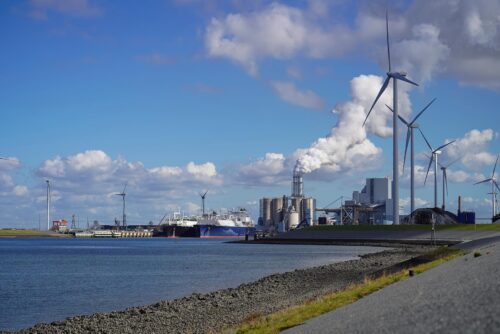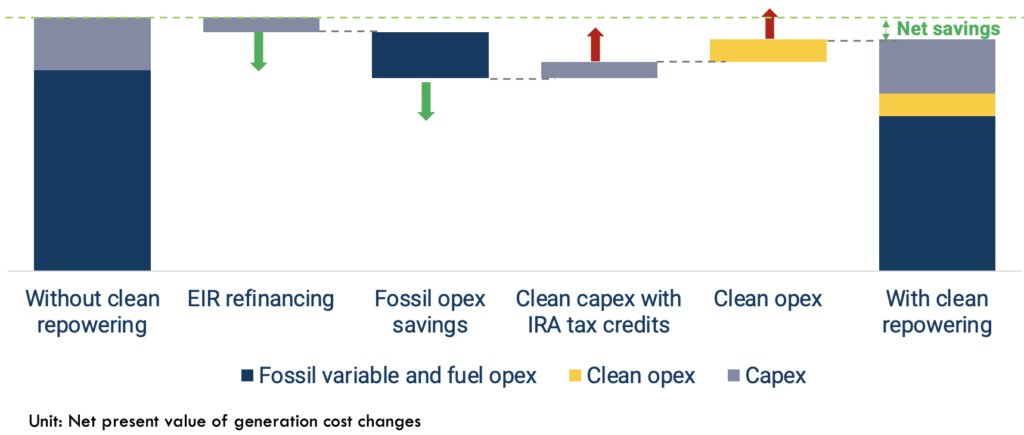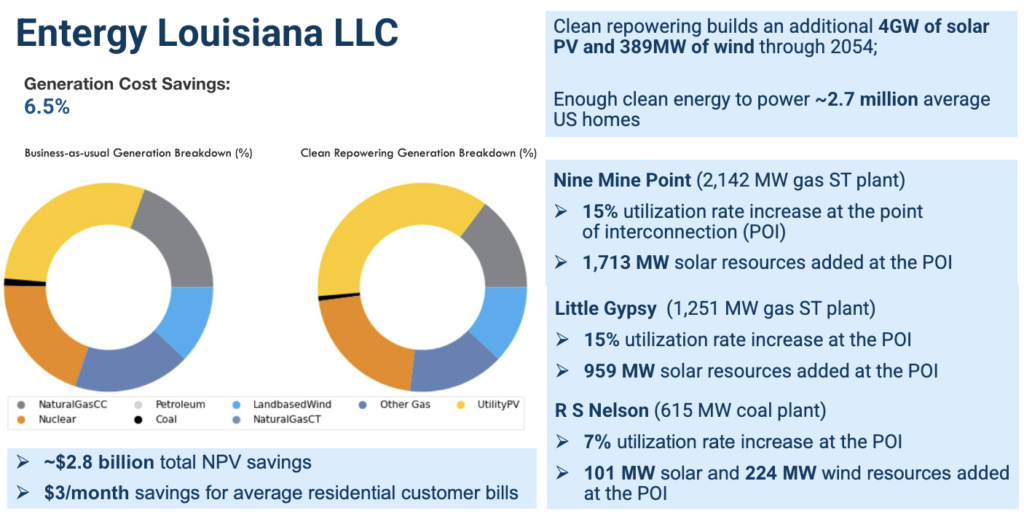
How Utility Regulators Can Unlock $12.7 Billion in Annual Savings for Customers
The clean repowering opportunity, propelled by Inflation Reduction Act (IRA) incentives and programs, offers the potential for 250 GW of new renewable energy projects without requiring any transmission upgrades.
It can take nearly half a decade for new resources such as solar and wind projects to connect into the utility grid. This lengthy interconnection process hamstrings the development of our energy systems during a crucial time for growth. There’s good news, though: Utilities can bypass the interconnection process by siting new clean generation at the same point of interconnection as existing or retiring generators. Using the existing fossil asset interconnection rights can cut the interconnection time down to less than one year. We call this project development strategy “clean repowering.”
Our analysis shows that the clean repowering opportunity, propelled by Inflation Reduction Act (IRA) incentives and programs, offers the potential for 250 GW of new renewable energy projects without requiring any transmission upgrades. This translates to an average of $12.7 billion in savings nationally every year for the next 10 years starting in 2025. Vertically integrated utilities alone are projected to realize $46 billion in savings in net present value (NPV) between now and 2054.
To help regulators understand the size of the clean repowering opportunity in their jurisdictions, RMI has developed a web-based interactive tool known as the IRA Opportunity Map. The tool features a map that illustrates the extent of nationwide cost savings from clean repowering. Users also have the option to zoom in on individual utilities to explore the key drivers behind these opportunities.
Our analysis suggests that 18 utilities have the potential to realize NPV savings in the billions, with the majority of investor-owned utilities experiencing savings in the millions. Notably, MISO, PJM, and the Southeast region present the greatest opportunity for savings driven by clean repowering. The chart below shows the top 10 vertically integrated utilities that stand to benefit from IRA incentives targeting clean repowering (Exhibit 1).
Here’s how it all pencils out
Clean repowering can save both time and money. It allows for clean energy to connect to the grid in just under a year by using surplus interconnection or generator replacement interconnection processes at existing fossil sites. It saves customers money by using fossil fuel-burning plants less — and thereby avoiding uncertain future fuel costs as well as variable operating costs. Before the passage of the IRA, many utilities may have found that these cost savings could not overcome the high up-front costs of building new clean energy as well as additional costs from more frequent start-ups and ramping. However, the IRA made key changes to the tax code and introduced a key new financing program, the Energy Infrastructure Reinvestment (EIR) program, which now means that tax credits and low-cost financing can more than offset those incremental costs, creating the potential for net savings from rapid clean energy deployment. The following chart illustrates the cost savings opportunities.
Exhibit 2: How Clean Repowering Creates Savings for Customers
Entergy Louisiana is a great example of the clean repowering savings potential; by taking advantage of this opportunity, Entergy can anticipate substantial savings in total customer costs starting in 2025. This can be achieved by operating their coal and gas fleet less while investing in solar and wind projects, leading to a projected $2.8 billion in NPV savings. Louisiana’s Nine Mile Points gas plant (2 GW capacity) has the greatest potential for clean repowering deployment. There is an opportunity to build 1,713 MW of solar capacity and increase utilization rates at this interconnection point by 15 percent. The R S Nelson coal plant (600 MW capacity) has the potential to avoid 383,555 tons of CO2 per year by implementing a clean repowering plan of 101 MW of solar and 224 MW of wind capacity.
Exhibit 3: Entergy Louisiana Savings Opportunities from Clean Repowering
Now is the time to act: Prompt regulatory action can unlock this no-regrets opportunity
Clean repowering creates win-win opportunities for utilities and customers. However, these opportunities can only be realized if utilities move quickly to incorporate it into their planning and investment decision-making processes. Utilities may be disinclined to voluntarily take such actions absent regulatory guidance and oversight. Regulators can act to prompt clean repowering uptake through the following efforts:
- During or in advance of the integrated resource planning (IRP) process, ask utilities to elaborate on their near-term investment plans to ensure the IRA benefits are optimized to harness clean repowering in their resource operation and investment plans. This is particularly important where utilities are proposing to delay fossil retirements in the context of load growth.
- In IRPs, rate cases, or related proceedings (e.g., asset retirement proceedings), investigate in detail how the utility chose to account for IRA tax and financing benefits in resource planning, ratepayer cost, and customer bill impact modeling. This is a critical step to make sure the savings are effectively flowing to the customers.
- Ask utilities to report to the commission on how they plan to utilize the DOE’s EIR program before its authorization expires on September 30th, 2026.
- Ask utilities to explore and report to the commission on how they plan to leverage expedited interconnection fast track rules (both surplus interconnection and generator replacement as appropriate), either by identifying priority locations or developing regulatory mechanisms that will encourage the utility to use fast tracks.
RMI’s IRA Opportunity Map provides solid evidence for regulators to reference as they take these actions. In addition, RMI’s Regulatory Collaborative can help regulators develop implementation strategies to explore clean repowering and IRA opportunities based on these analytical tools.
If you are interested in learning more about the IRA Opportunity Map tools and analysis, visit the FAQ and Resources page. If you would like to find out how RMI can provide support to help you leverage IRA incentives to create customer savings in your state, please contact us.
Additional technical and editorial support provided by RMI colleagues: Ben Proffer, Uday Varadarajan, Gennelle Wilson, Rachel Gold, Joseph Daniel, Alex Engel, Maria Castillo, Diego Angel, Katie Siegner
Correction as of February 15, 2024: A previous version of this article incorrectly stated in Exhibit 3 that the total clean energy additions possible through Clean Repowering is 107 GW of solar PV and 12 GW of wind through 2054. It is actually 4 GW of solar PV and 389 MW of wind through 2054.

